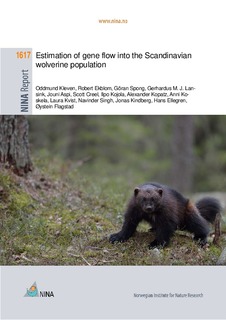Estimation of gene flow into the Scandinavian wolverine
Kleven, Oddmund; Ekblom, Robert; Spong, Göran; Lansink, Gerhardus M. J.; Aspi, Jouni; Creel, Scott; Kojola, Ilpo; Kopatz, Alexander; Koskela, Anni; Kvist, Laura; Singh, Navinder; Kindberg, Jonas; Ellegren, Hans; Flagstad, Øystein
Research report

Åpne
Permanent lenke
http://hdl.handle.net/11250/2592962Utgivelsesdato
2019Metadata
Vis full innførselSamlinger
- NINA Rapport/NINA Report [2341]
Sammendrag
Kleven, O., Ekblom, R., Spong, G., Lansink, G. M. J., Aspi, J., Creel, S., Kojola, I., Kopatz, A., Koskela, A., Kvist, L., Singh, N., Kindberg, J., Ellegren H. & Flagstad, Ø. 2019. Estimation of gene flow into the Scandinavian wolverine population. NINA Report 1617. Norwegian Institute for Nature Research.
Commissioned by the Swedish Environmental Protection Agency (SEPA), a project was conducted to provide data for the current evaluation of favourable conservation status of the wolverine in Sweden. In this report we present the results from this project, in which the main aim was to estimate gene flow into the Scandinavian, and in particular the Swedish wolverine population. Applying different genetic markers, a comprehensive sampling and various statistical ap-proaches, we examined the population genetic structure and connectivity of wolverines in Fennoscandia. We found that wolverines in central Scandinavia were genetically different from those in northern Fennoscandia (i.e., the counties Troms and Finnmark in northern Norway, the northernmost part of Norrbotten in Sweden, and most of Lappland in northern Finland), and wolverines in southern Finland formed a separate genetic cluster. Although there was evidence of genetic substructuring, the change was gradual and showed a pattern of isolation-by-distance. Dispersal events were common but not symmetrical between the identified genetic clusters. Migration rates between central Scandinavia and northern Fennoscandia, as well as from northern Fennoscandia to southern Finland, was moderate, while it was low from southern Finland to the other two sub-populations. Based on the current population size, we estimated that 15-22 wolverines from northern Fennoscandia, and 0.04-0.46 wolverines from southern Finland have migrated into the central Scandinavian sub-population, which included a large part of the Swedish wolverine population, per generation. Despite limited influx of eastern wolverines, our findings indicate the potential for gene flow into the Swedish population, and most likely so through the corridor in northern Fennoscandia. Kleven, O., Ekblom, R., Spong, G., Lansink, G. M. J., Aspi, J., Creel, S., Kojola, I., Kopatz, A., Koskela, A., Kvist, L., Singh, N., Kindberg, J., Ellegren H. & Flagstad, Ø. 2019. Estimering av genflyt til den Skandinaviske jerv populasjonen. NINA Rapport 1617. Norsk institutt for naturforskning.
På oppdrag fra Naturvårdsverket ble et prosjekt gjennomført for å fremskaffe data til en forestående vurdering av bevaringsstatus for jerv i Sverige. I denne rapporten presenterer vi resultatene fra dette prosjektet, hvor hovedformålet var å estimere genflyt til den skandinaviske, og spesielt til den svenske jerv-bestanden. Ved å benytte ulike genetiske markører, et betydelig antall prøver og ulike statistiske analyser, undersøkte vi populasjonsgenetisk struktur og konnektivitet blant jerv i Fennoskandia. Vi fant at jerv i den sentrale delen av Skandinavia var genetisk forskjellig fra jerv i det nordlige området av Fennoskandia (det vil si fylkene Troms og Finnmark, den nordligste delen av Norrbotten i Sverige og det meste av Lappland i Nord-Finland), og at jervene i det sørlige Finland utgjorde en egen genetisk gruppe. Selv om det var evidens for genetisk strukturering, var endringene gradvise og viste et mønster som samsvarte med isolasjon basert på geografisk avstand. Vandringer var vanlige, men de forekom ikke i like stor grad mellom de ulike genetiske gruppene. Migrasjonsratene mellom midt-Skandinavia og nordlige Fennoskandia, samt fra nordlige Fennoskandia til sørlige Finland, var moderat, mens det var lavt fra sørlige Finland til de andre to delpopulasjonene. Basert på den nåværende bestands-størrelsen, estimerte vi at 15-22 jerver fra nordlige Fennoskandia, og 0,04-0,46 jerver fra sørlige Finland har migrert til den midt-skandinaviske delpopulasjonen, som inneholder er stor andel av den svenske jerv-bestanden, per generasjon. På tross av begrenset immigrasjon av jerv fra østlige områder, så indikerer våre resultater at det er potensiale for genflyt inn til den svenske populasjonen av jerv, og da spesielt via korridoren i det nordlige Fennoskandia.